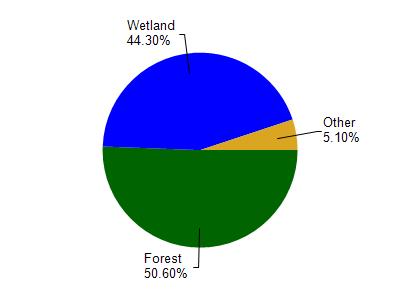Lincoln
No
No
Yes
Fish and Aquatic Life
Overview
Somo Lake , in the Somo River Watershed, is a 404.01 acre lake that falls in Lincoln County. This lake is managed for fishing and swimming and is currently considered impaired.
Date 2011
Author Aquatic Biologist
Historical Description
Source: 1982, Surface Water Resources of Lincoln County Somo Lake, T35N, R5E, Sec. 16 Surface Ahres = 339.7, Maximum Depth = 25 feet, Secchi Disc = 3 feet.
A very soft water drainage lake having neutral, light brown water of low transparency. The shoreline is 80 percent upland of hardwoods and conifer and 20 percent shrub bog wetland. The littoral zone is 70 percent sand, 20 percent muck, 5 percent gravel, 3 percent rubble and 2 percent boulder. Submergent vegetation is moderate in 33 percent of the lake basin and emergent and floating vegetation are moderately dense in some areas. There are 3 inlets: the Little Somo River, Creek 9-11, and Creek 17-4. The outlet, Little Somo River, is navigable and flows to the Big Somo River. The known fish population includes muskellunge, northern pike, walleye, perch, largemouth bass, smallmouth bass, bluegill, black crappie, rock bass, pumpkinseed, black bullhead, brown bullhead, white sucker, redhorse, common shiner and golden shiner. The lake is used by nesting puddle ducks and possibly by spring and fall migratory waterfowl. Public access is available from 2 boat landings, one of which has parking and by navigable water via Little Somo River. There are 125 dwellings and 4 resorts on the lakeshore.
Date 1982
Author Surface Water Inventory Of Wisconsin
Condition
Wisconsin has over 84,000 miles of streams, 15,000 lakes and milllions of acres of wetlands. Assessing the condition of this vast amount of water is challenging. The state's water monitoring program uses a media-based, cross-program approach to analyze water condition. An updated monitoring strategy (2015-2020) is now available. Compliance with Clean Water Act fishable, swimmable standards are located in the Executive Summary of Water Condition in 2018. See also the 'monitoring and projects' tab.
Reports
Management Goals
Wisconsin's Water Quality Standards provide qualitative and quantitative goals for waters that are protective of Fishable, Swimmable conditions [Learn more]. Waters that do not meet water quality standards are considered impaired and restoration actions are planned and carried out until the water is once again fishable and swimmable
Management goals can include creation or implementation of a Total Maximum Daily Load analysis, a Nine Key Element Plan, or other restoration work, education and outreach and more. If specific recommendations exist for this water, they will be displayed below online.
Monitoring
Monitoring the condition of a river, stream, or lake includes gathering physical, chemical, biological, and habitat data. Comprehensive studies often gather all these parameters in great detail, while lighter assessment events will involve sampling physical, chemical and biological data such as macroinvertebrates. Aquatic macroinvertebrates and fish communities integrate watershed or catchment condition, providing great insight into overall ecosystem health. Chemical and habitat parameters tell researchers more about human induced problems including contaminated runoff, point source dischargers, or habitat issues that foster or limit the potential of aquatic communities to thrive in a given area. Wisconsin's Water Monitoring Strategy was recenty updated.
Grants and Management Projects
Monitoring Projects
| WBIC | Official Waterbody Name | Station ID | Station Name | Earliest Fieldwork Date | Latest Fieldwork Date | View Station | View Data |
|---|
| 1547700 | Somo Lake | 10056283 | Somo Lake Launch - County Hwy CC | 8/6/2022 | 8/20/2022 | Map | Data |
| 1547700 | Somo Lake | 353234 | Somo Lake - Center | | | Map | Data |
| 1547700 | Somo Lake | 10020010 | Somo Lake -- Access | | | Map | Data |
| 1547700 | Somo Lake | 10003447 | Somo Lake | 8/29/2000 | 6/22/2022 | Map | Data |
| 1547700 | Somo Lake | 353135 | Somo Lake - 3/4 Mile DownstreamSouth Side Of River | 3/12/1997 | 10/18/1997 | Map | Data |
|

Watershed Characteristics
Somo Lake is located in the Somo River watershed which is 141.31 mi². Land use in the watershed is primarily forest (50.60%), wetland (44.30%) and a mix of grassland (2.10%) and other uses (3.00%). This watershed has 168.64 stream miles, 643.93 lake acres and 31,815.14 wetland acres.
Nonpoint Source Characteristics
This watershed is ranked Not Ranked for runoff impacts on streams, Low for runoff impacts on lakes and Low for runoff impacts on groundwater and therefore has an overall rank of Low. This value can be used in ranking the watershed or individual waterbodies for grant funding under state and county programs.However, all waters are affected by diffuse pollutant sources regardless of initial water quality. Applications for specific runoff projects under state or county grant programs may be pursued. For more information, go to surface water program grants.